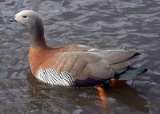
Ashy-headed Goose
Encyclopedia
The Ashy-headed Goose (Chloephaga poliocephala) is a large sheldgoose
, which breeds in mountainous areas of southernmost South America
and winters
on lowlands just north of its breeding range.
The lined nest is built in tall grass, and 4–6 eggs are laid. This terrestrial species favours damp upland forest clearings and feeds by grazing; it rarely swims.
In flight, this species shows black primaries, with the rest of the wing white except for a broad green bar. The male's call is a soft whistle, and the female's is a harsh cackle.
Tadorninae
The Tadorninae is the shelduck-sheldgoose subfamily of the Anatidae, the biological family that includes the ducks and most duck-like waterfowl such as the geese and swans....
, which breeds in mountainous areas of southernmost South America
South America
South America is a continent situated in the Western Hemisphere, mostly in the Southern Hemisphere, with a relatively small portion in the Northern Hemisphere. The continent is also considered a subcontinent of the Americas. It is bordered on the west by the Pacific Ocean and on the north and east...
and winters
Bird migration
Bird migration is the regular seasonal journey undertaken by many species of birds. Bird movements include those made in response to changes in food availability, habitat or weather. Sometimes, journeys are not termed "true migration" because they are irregular or in only one direction...
on lowlands just north of its breeding range.
The lined nest is built in tall grass, and 4–6 eggs are laid. This terrestrial species favours damp upland forest clearings and feeds by grazing; it rarely swims.
Description
The Ashy-headed Goose is a stocky 50 centimetre bird with a pale brown back, chestnut neck and black-barred white flanks. The head is grey and paler over the crown. The inside of the legs are black and the outside of the legs are red. Sexes are similar, except that the male may have reduced or no underparts barring. Immature birds are duller and have brown heads.In flight, this species shows black primaries, with the rest of the wing white except for a broad green bar. The male's call is a soft whistle, and the female's is a harsh cackle.

